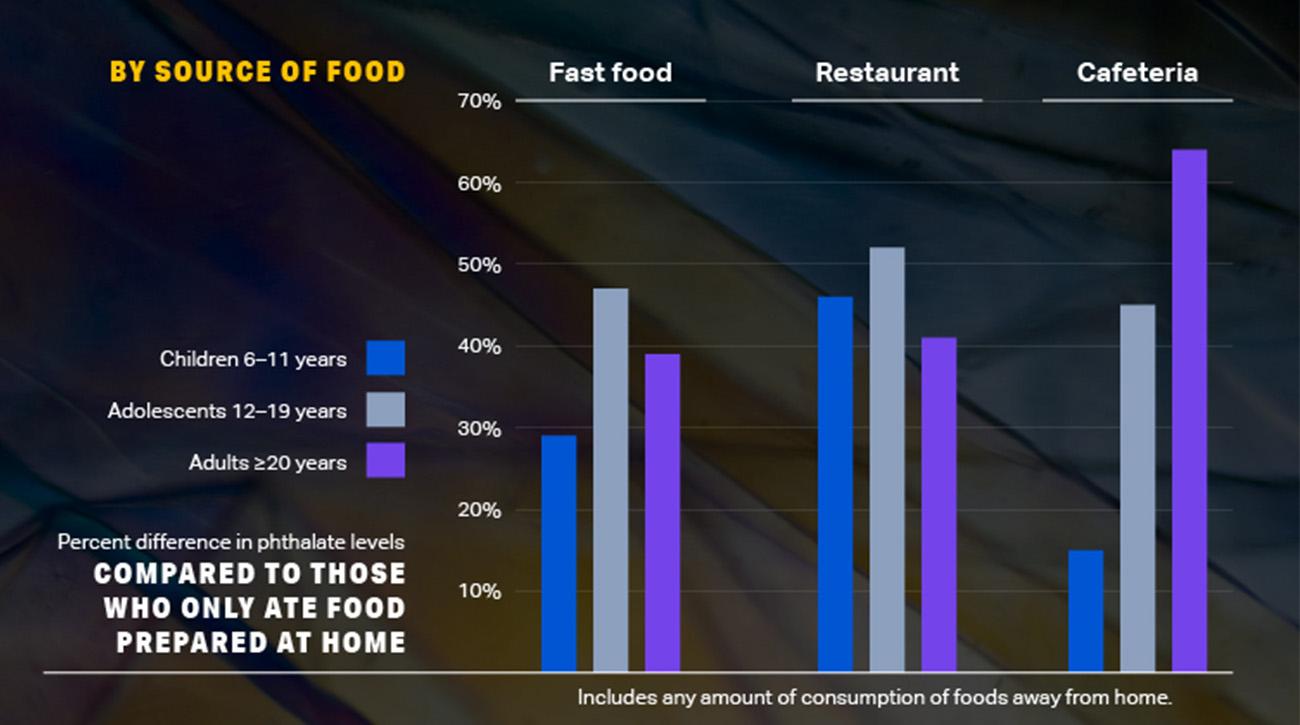Dining out more at restaurants, cafeterias and fast-food establishments could boost total levels of potentially health-harming chemicals called phthalates in the body, according to a recent study by a Milken Institute School of Public Health researcher.
Phthalates—a group of chemicals used in food packaging and processing materials—are known to disrupt hormones in humans and are linked to a long list of health problems, including reproductive issues. People who reported consuming more restaurant, fast food and cafeteria meals had phthalate levels that were nearly 35 percent higher than people who reported eating food mostly purchased at the grocery store, according to the study.
“This study suggests food prepared at home is less likely to contain high levels of phthalates, chemicals linked to fertility problems, pregnancy complications and other health issues,” said Ami Zota, an SPH assistant professor of environmental and occupational health and a senior author on the study. “Our findings suggest that dining out may be an important, and previously under-recognized, source of exposure to phthalates for the U.S. population.”
The study is the first to compare phthalate exposures in people who reported dining out to those more likely to enjoy home-cooked meals.
Dr. Zota and her colleagues, including lead author Julia Varshavsky from the University of California, Berkeley, used data from the National Health and Nutrition Examination Survey (NHANES) collected between 2005 and 2014. The 10,253 participants in the study were asked to recall what they ate and where their food came from in the previous 24 hours. The researchers then analyzed the links between what people ate and the levels of phthalate break-down products found in each participant’s urine sample.
The team found that 61 percent of the participants reported dining out the previous day. In addition, the researchers found:
- The association between phthalate exposure and dining out was significant for all age groups but the magnitude of association was highest for teenagers.
- Adolescents who were high consumers of fast food and other food purchased outside the home had 55 percent higher levels of phthalates compared to those who only consumed food at home.
- Certain foods, and especially cheeseburgers and other sandwiches, were associated with increased levels of phthalates—but only if they were purchased at a fast-food outlet, restaurant or cafeteria. The study found that sandwiches consumed at fast food outlets, restaurants or cafeterias were associated with 30 percent higher phthalate levels in all age groups.
It is important to limit pregnant women, children and teens’ exposure to the toxic effects of hormone-disrupting chemicals, Dr. Varshavsky said. Future studies should investigate the most effective interventions to remove phthalates from the food supply.

(Courtesy of the Milken Institute School of Public Health)
A 2016 study by Dr. Zota and colleagues suggested that fast food may expose consumers to higher levels of phthalates. That study found people who ate the most fast food, burgers, fries and other foods, had phthalate levels that were as much as 40 percent higher than people who rarely ate such foods.
The new study looked more broadly at dining out—not just at fast-food establishments—and found it was significantly associated with increased exposure to phthalates. The findings are worrisome because two-thirds of the United States population eats at least some food outside the home daily, the authors said.
“Our data suggests that phthalate contamination of the food supply is a widespread problem and one that we need to address,” Dr. Zota said.
The team used an innovative method of assessing real-world exposures to multiple phthalates, called cumulative phthalate exposure, which takes into account evidence that some phthalates are more toxic than others. The National Academies of Sciences has weighed in twice on phthalates. It recommended using cumulative risk assessments in order to estimate the human health risk posed by this class of chemicals in a 2008 report, and reported that certain phthalates are presumed to be reproductive hazards to humans in 2017.
Many products contain phthalates, including take-home boxes, gloves used in handling food, food processing equipment and other items used in the production of restaurant, cafeteria and fast food meals. Previous research suggests these chemicals can leach from plastic containers or wrapping into food.
Home-cooked meals may be one way to limit exposure to these harmful chemicals.
“Preparing food at home may represent a win-win for consumers,” Dr. Zota said. “Home cooked meals can be a good way to reduce sugar, unhealthy fats and salt. This study suggests it may not have as many harmful phthalates as a restaurant meal.”
At the same time, phthalate contamination of the food supply also represents a larger public health problem that must be addressed by policymakers. Previous research by Dr. Zota and Tracey Woodruff from the University of California, San Francisco, shows policy actions, such as bans, can help reduce human exposure to harmful phthalates.
“This problem has to be addressed at a more systemic level so that everyone truly can have access to healthy food,” Dr. Zota said.
The study appeared online in Environment International on Friday.




